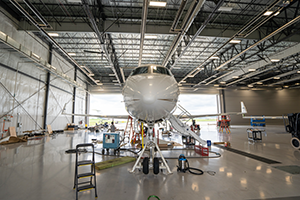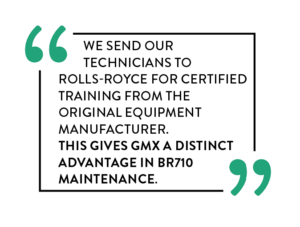This is how camera scopes save jet owners time and money
Borescope inspections are essential for ensuring the proper functioning of turbine engines. These engines contain many internal parts — compressor blades, turbine blades, combustion chambers — that require regular checks for wear and damage. Borescopes are the best way to inspect these parts that doesn’t require invasive maintenance.
Here at Global MX, we are experts in borescope inspections. We specialize in every facet of servicing the BR710 engines on Gulfstream and Bombardier aircraft. Contact us with any questions about your maintenance needs for these crafts.
Here’s an overview of what borescope inspections are and how they benefit the long-term viability of your aircraft and your investment.
What is the process like? What tools are used?
GMX uses a GE Mentor Visual iQ borescope, one of the most advanced instruments of its kind on the market. It has a flexible tube adapter with an LED light to provide clear imaging of the engine interior.
This borescope is also capable of 3D mapping the interior of the engine and taking precise measurements of any potential issues. That information may be quickly sent to equipment engineers for diagnosis and repair, saving valuable time during AOG events.
When do engines need borescope inspections?
Borescope inspections are required after major flight events that may have caused engine damage, including bird or lightning strikes. During routine operation, many modern aircraft can spot abnormal engine performance through their Engine-Indicating and Crew-Alerting System. The data collected by EICAS sensors might necessitate further interrogation with a borescope.We often recommend borescope inspections as a component of pre-purchase inspections, especially when the engines are nearing the completion of their maintenance cycle. They may also be required (or strongly recommended) by engine maintenance programs at various flight hour or flight cycle intervals.
The original equipment manufacturer, in our case Rolls-Royce, might also necessitate a borescope inspection by sending out a notice of defect. These instruct maintenance providers to shorten the interval until an engine’s next inspection to check on specific issues.
Is there specific training required to perform borescope inspections?
We send our technicians to Rolls-Royce for certified training from the original equipment manufacturer. This gives GMX a distinct advantage in BR710 maintenance.
 “A lot of repair stations don’t have in-house borescope technicians,” says Ray Clapp, Chief Inspector at GMX. “The training is expensive, so when a craft comes in for maintenance, repair stations often use a third-party contractor for the borescope. And they’re limited on which contractor to use, because inspectors are usually trained on just one engine. It can be difficult to schedule in a timely fashion.”
“A lot of repair stations don’t have in-house borescope technicians,” says Ray Clapp, Chief Inspector at GMX. “The training is expensive, so when a craft comes in for maintenance, repair stations often use a third-party contractor for the borescope. And they’re limited on which contractor to use, because inspectors are usually trained on just one engine. It can be difficult to schedule in a timely fashion.”
Our borescope is small enough to transport to other stations, so GMX can act as that third-party contractor. But it’s one more maintenance capability that Gulfstream owners appreciate having in-house at GMX.
What do these inspections reveal? What are the benefits?
When engines are subjected to foreign objects or debris, borescopes are the primary tool used to quickly determine the extent of damage and recommend the means of repair. But during routine maintenance, they also spot small cracks or failures in turbine or compressor blades, stator vanes, and combustion liners, plus erosion and corrosion on guide vanes and turbine blades.
By detecting small problems before they become major defects, a borescope inspection helps save on operating costs. It’s a great measure to minimize downtime, enhance the reliability of your craft, and provide comprehensive documentation to help with future maintenance.
